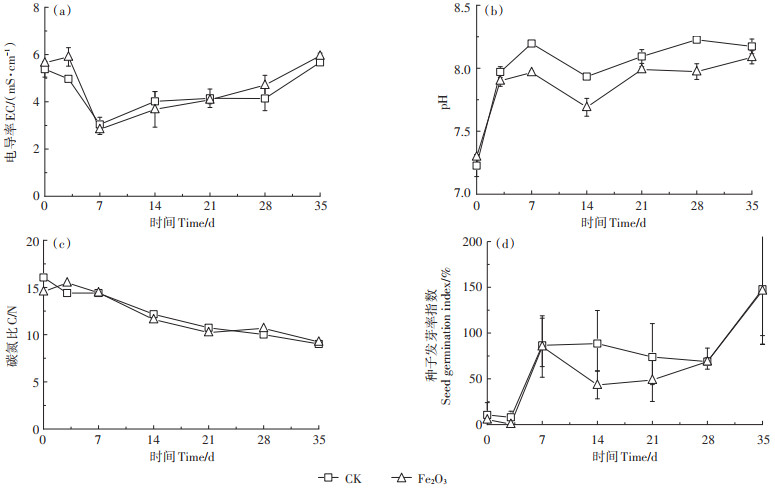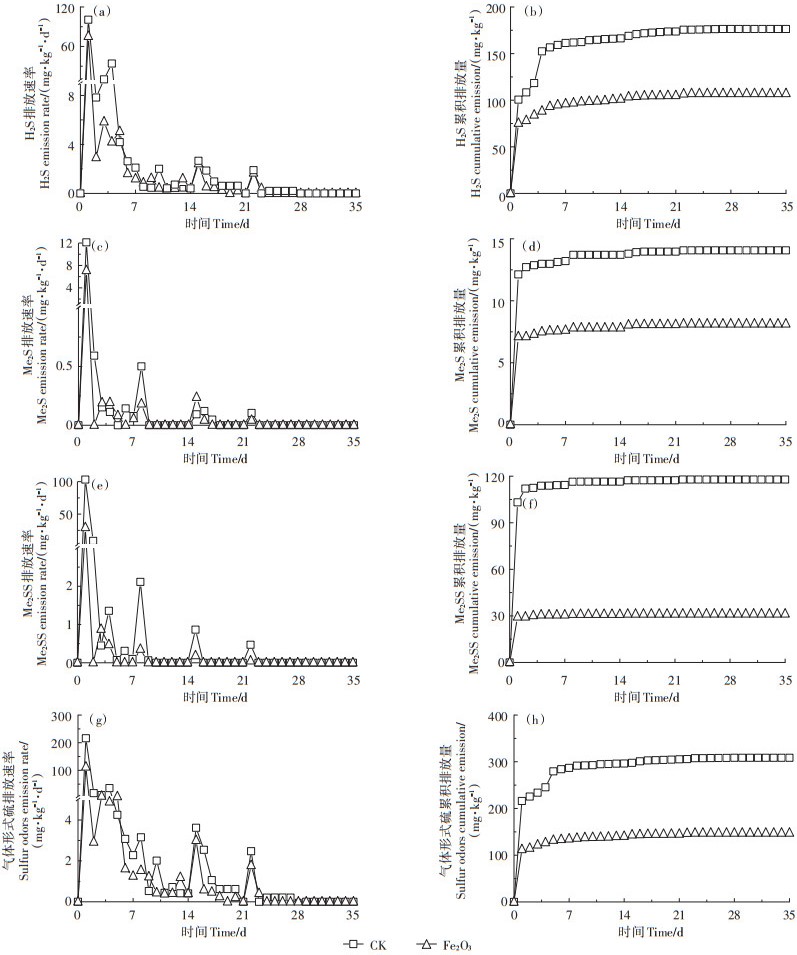近年来,居民对动物产品如肉蛋奶的需求不断增加。预计到2030年,全球对鸡肉和鸡蛋的需求将分别较2020年增长61% 和39%[1]。这使得畜禽养殖业迅速向规模增大、集约化水平升高的方向发展,造成鸡粪等畜禽粪便的大量累积。然而,不经妥善处理的畜禽粪便会造成严重的环境问题,包括恶臭气体的排放、土壤和水污染等[2-3]。因此,寻找一种安全有效的畜禽粪便处理方法至关重要。堆肥是一种环境友好的固体废弃物处理方式,可以将动物粪便转化为有机肥料以减少其对环境的危害[4]。但畜禽粪便堆肥过程会产生硫化氢、粪臭素(甲基吲哚)、脂肪族的醛类、硫醇、胺类和氨气等臭气[5],其浓度通常很高,其中氨气(NH3)和硫化氢(H2S)为主要的臭气[6],但臭气物质远不止这两类,其中的互相转化也较为复杂。目前堆肥厂恶臭排放已经成为制约畜禽粪便堆肥资源化利用的主要问题[7]。
目前,针对堆肥过程臭气排放,大多数研究聚焦于NH3的减排,如使用牛粪与鸡粪进行共堆肥[1],通过对粪便进行酸化前处理[8],使用外源添加剂如磷石膏、钙镁磷肥、沸石或生物炭等[9-11],已取得较好的减排效果。在厌氧条件下,由微生物还原硫酸盐或分解含硫有机成分产生的含硫气体是导致有机废弃物堆肥过程中产生恶臭的一组重要化合物,尽管含硫臭气的浓度较低,但其嗅觉阈值却很低[12]。目前,对于含硫臭气中H2S减排方法的研究较多,如调节初始碳氮比、改变通风方式、进行有机覆盖、使用添加剂等[13-15]。然而除H2S外,堆肥过程还会产生其他种类的含硫臭气,包括二甲基二硫醚(Me2SS)、甲硫醚(Me2S)、二硫化碳(CS2)、乙硫醚(Et2S)、甲硫醇(MeSH)、羰基硫(COS)等。虽然不同含硫臭气在堆肥过程中释放浓度会有差异,但这些臭气具有相似的排放规律,主要是在堆肥过程的前期排放[16-18]。
然而,目前对于粪便堆肥中含硫臭气减排的研究相对较少,有学者研究发现铁盐在堆体中可通过形成FeS降低含硫气体的产生,添加FeCl3在厨余垃圾堆肥中可以获得较好的臭气减排效果[19],但会增加堆肥产品中氯离子含量,对作物生长造成影响。因此,本文旨在研究可用于替代FeCl3添加剂的Fe2O3对鸡粪堆肥腐熟度和含硫臭气排放的影响,通过外源铁剂的添加固定堆肥过程中的硫养分,减少含硫臭气排放。研究成果可为我国畜禽粪便生物转化过程臭气控制提供数据支撑。
1 材料与方法 1.1 试验装置与材料来源试验地点为中国农业大学上庄试验站,堆肥原料为新鲜鸡粪和玉米秸秆。鸡粪取自中国农业大学动物科学技术学院养鸡场,秸秆取自中国农业大学上庄试验站,Fe2O3购于北京广达恒益科技有限公司。鸡粪和玉米秸秆的基本理化性质见表 1。
|
|
表 1 堆肥初始物料基本理化性质 Table 1 Physiochemical characteristics of composting raw materials |
将鸡粪、秸秆及Fe2O3于试验初始时混匀,装入如图 1所示的堆肥发酵罐中,其中鸡粪和玉米秸秆的添加量以湿质量计,添加比例为5.7∶1,Fe2O3的添加量以混合物料的总氮摩尔数计,添加比例为7.5%。调节初始混合物料的含水率为62%,通风方式为连续通风,通风速率为0.2 L·kg-1·min-1(以干质量计)。试验设置2个处理,对照处理不添加Fe2O3(CK),试验处理添加Fe2O3(Fe2O3)。

|
图 1 堆肥装置 Figure 1 Schematic diagram of composting reactor |
试验周期为35 d,堆体温度由温度传感器测定,自动测温仪(175-T3,Testo,德国)通过红外装置接收读取数据。堆肥试验开始后分别于第0、3、7、14、21、28 d和35 d在堆体中取混合新鲜样品500 g,分成两份。一份用于含水率的测定,105 ℃烘干后使用元素分析仪(vario MACRO cube,Hananu,德国)进行总碳(TC)和总硫(TS)含量的测定;另一份制备水浸提液(固液比1∶10)并使用多参数分析仪(DZS-706-A,雷磁,上海)测定pH和EC。取上述水浸提液5 mL于盛有10粒萝卜种子并铺有滤纸的培养皿中,置于(20± 1)℃的培养箱(SHP-250,精宏,上海)中避光培养48 h,测定种子发芽指数(GI)。通过便携式沼气分析仪(Biogas 5000,Geotech,英国)于每日固定时间直接读数测定CO2含量。此外,于每日固定时间使用铝箔采气袋在容器的排气管收集气体,使用带三相阀门的注射器(德国)抽取25 mL收集的气体,通过气相色谱仪(GC-A90,Echrom,中国)进行7种含硫气体(Me2SS、Me2S、CS2、Et2S、MeSH、COS和H2S)的测定。
1.4 数据处理与分析试验数据以均值表示,使用SPSS Statistics 26对不同处理进行相关性及显著性差异检验,使用Origin 2018做图。
2 结果与讨论 2.1 温度和CO2在堆肥过程中,温度可以反映微生物的代谢活性,当微生物活动较剧烈时,堆体中易降解有机物分解,产生大量的CO2,同时堆体温度升高[20]。两处理堆体温度变化如图 2(a)所示,CK处理最高温为73.8 ℃,Fe2O3处理最高温度略低,为71.1 ℃,且65 ℃以上高温期减少5 d,这可能是由于添加剂的加入影响了微生物的代谢活动。统计分析结果表明,两处理温度变化差异极显著(P < 0.01)。每次翻堆后,物料充分接触,氧气重新分配,使得堆体温度较翻堆前有所升高。堆肥温度随着有机质降解完全逐渐降低。图 2(b)为不同处理下CO2含量的变化趋势图。两处理CO2含量均在0.2%~12.4%,堆肥过程温度和CO2含量呈现显著正相关(r=0.770,P < 0.01),堆肥前期CO2浓度迅速增加,持续一定时间后开始降低,每次翻堆后浓度有所回升,最后逐渐趋于稳定。

|
图 2 不同鸡粪堆肥处理的温度和CO2含量变化 Figure 2 Changes of temperature and CO2 content in different treatments during chicken manure composting |
堆肥中的小分子有机物和无机盐会对作物产生毒害作用,电导率(EC)反映了堆肥中可溶性盐的含量,堆肥电导率不宜过高,超过4 mS·cm-1可能会对作物产生不利影响[21]。图 3(a)为不同处理下EC值的变化趋势图,两处理变化趋势基本一致,差异不显著(P> 0.05)。Fe2O3处理的初始EC略高于CK处理,且在堆肥初期,Fe2O3处理的EC值略有升高,这可能是由于Fe离子的影响。随着堆肥过程的进行,铵态氮以气体的形式挥发,小分子有机酸逐渐挥发和降解,两处理的EC值均开始降低,在第7 d达到最低值。翻堆后EC值逐渐上升,最终达到5.5 mS·cm-1左右。堆肥结束后EC值仍较高,这可能与鸡粪较高的EC值有关,也可能是有机质降解导致物料中盐分离子浓缩,表明鸡粪作为堆肥原料,需要重点关注EC对土壤和作物的影响,可进一步延长堆肥期[22]。

|
图 3 鸡粪堆肥不同处理腐熟度指标的变化 Figure 3 Changes of maturity indices in different treatments during chicken manure composting |
pH值过高或过低都会通过影响微生物的代谢活性来降低有机质的分解速率,当pH过高时会促进氮素挥发,降低堆肥肥效[23]。不同处理的pH值变化如图 3(b)所示,两处理的pH值均在堆肥前期出现上升趋势,主要是堆肥前期有机氮的矿化所致。第7~14 d,由于高温阶段有机质剧烈分解,大量的NH3挥发,pH值有所降低。随着堆肥过程进行,NH3挥发速率逐渐降低,pH在第21 d趋于稳定。我国《有机肥料》(NY 525—2021)标准要求堆肥的pH值在5.5~8.5,堆肥结束时,两处理的pH值均为8.0左右,满足腐熟堆肥产品的弱碱要求[24]。
堆肥C/N是最为常用的堆肥产品质量和腐熟度评价指标之一,也是影响堆肥发酵过程的重要因素[25]。鸡粪的初始C/N较低,因此在初始阶段加入秸秆调节C/N使其更适于堆肥过程的进行[26]。图 3(c)为堆肥过程C/N变化趋势,随着微生物对有机质降解,总碳含量下降,总体C/N下降,这与已报道的研究结果相一致[27]。一般来说,当固相C/N < 20时堆肥达到腐熟或者是腐熟的必要条件[28],但是并不适用于低C/N的鸡粪堆肥,马若男等[13]发现鸡粪堆肥C/N降低35% 以上,可认为达到腐熟。经过35 d堆肥后,两处理的C/N分别为9.00和9.23,降低了约40%,达到腐熟状态。
种子发芽率指数(GI)是衡量堆肥腐熟度的重要指标,根据我国《有机肥料》(NY 525—2021)标准,当GI≥70% 时,堆肥产品可被认为处于完全腐熟状态。由图 3(d)可知,在堆肥初期,CK和Fe2O3处理的GI分别为10.51%和5.40%,对种子具有明显毒害作用。堆肥前期,易降解有机质、蛋白质和脂肪迅速分解,产生大量的铵态氮和小分子有机酸,导致GI降低;随着堆体温度逐渐升高以及NH3的挥发,两处理的GI值在第7 d显著增加。堆肥中后期,尚未分解的易分解有机物和较难分解的有机物继续分解导致堆体二次升温,这一过程的降解产物会对作物种子产生一定的毒害作用,GI值再次出现了下降趋势[29]。第28 d以后,堆肥进入后腐熟期,所有处理的GI值急剧上升,堆肥结束时两处理的GI值分别为147.82%和146.24%,差异不显著(P>0.05),均达到完全腐熟。
2.3 含硫臭气堆肥过程中存在局部厌氧区域,有机物在厌氧条件下分解会产生含硫臭气,这些含硫臭气之间可以发生相互转化,研究表明H2S是Me2S和Me2SS的重要前体物质,由于HS-的甲基化和氧化剂的作用,Me2SS和Me2S的排放量也相对较高[30-31],本研究结果与已有的研究结果一致[32-35]。其他含硫臭气在整个堆肥过程中排放量极少,且仅在个别时期有检测到。因此,本文主要针对H2S、Me2S和Me2SS这3种含硫臭气排放进行分析。如图 4所示,3种主要的含硫臭气表现出相似的排放规律,排放峰值均出现在堆肥第1 d,此后逐渐降低至检出限以下,排放浓度由高到低依次为H2S、Me2SS和Me2S。CK处理3种含硫臭气的累积排放量分别为176.41、117.82 mg·kg-1和14.07 mg·kg-1(以干质量计,下同);Fe2O3处理3种含硫臭气的累积排放量分别为107.21、31.22 mg·kg-1和8.12 mg·kg-1。与CK处理相比,添加Fe2O3对含硫臭气具有明显的减排效果(P < 0.01)。主要是由于在厌氧条件下,硫酸盐还原菌可以将SO42-还原为S2-,而Fe3+具有氧化性,因此可以作为电子受体与SO42-竞争,阻止S2-的生成,也可与生成的S2-反应生成FeS,减少堆肥过程中含硫臭气的排放[31]。YUAN等[19]在厨余垃圾堆肥过程中使用FeCl3降低了70%的H2S排放,高于本研究中对H2S减排,这可能与堆肥原料性质相关。总体而言,铁剂对于含硫臭气具有较好的固定作用。

|
图 4 鸡粪堆肥不同处理含硫臭气排放量的变化 Figure 4 Evolution of sulfur-containing odors emissions from different treatments during chicken manure composting |
堆肥过程碳和硫元素平衡如表 2所示,整个堆肥过程中没有产生渗滤液,堆肥过程中元素主要以气态形式损失。CK处理总碳损失率为65.07%,Fe2O3处理为60.10%,添加Fe2O3能够减少堆肥过程总碳损失。整个堆肥过程中,各处理总硫含量均增加,这是因为堆肥过程中有机物降解造成的碳素损失远高于硫素损失,硫元素发生相对浓缩[13]。CK处理总硫损失率为25.17%,Fe2O3处理总硫损失率为9.27%,Fe2O3添加降低了总硫损失。堆肥过程含硫气体主要以H2S、Me2SS和Me2S的形式损失,这一结果与已报道的结果一致[36]。CK处理3种含硫臭气占初始总硫损失的10.76%,而Fe2O3处理仅占4.47%。Fe2O3添加显著降低了鸡粪堆肥过程含硫臭气排放,其中对Me2SS的减排效果最好,减排率高达73.59%;Me2S次之,减排率为42.59%;H2S减排率为38.81%。
|
|
表 2 鸡粪堆肥不同处理C和S平衡分析(%) Table 2 The balance of carbon and sulfur in different treatments during chicken manure composting(%) |
(1)鸡粪堆肥添加Fe2O3可缩短堆体高温期持续时间,但不会对堆肥腐熟度产生影响,经35 d的堆肥后,两处理种子发芽指数均达到140%,达到腐熟要求。
(2)鸡粪堆肥过程产生的主要含硫臭气为H2S、Me2SS和Me2S,且主要在堆肥前期(0~7 d)排放,Fe2O3添加显著降低了TS损失(63.17%)和含硫臭气的排放,对主要含硫臭气硫化氢(H2S)、二甲基二硫醚(Me2SS)和甲硫醚(Me2S)的减排率分别为38.81%、73.59%和42.59%。
(3)总体而言,外源添加Fe2O3可显著降低含硫臭气排放,增加产品中硫养分含量,且不会影响堆肥进程和腐熟度。
| [1] |
HWANG H Y, KIM S H, KIM M S, et al. Co-composting of chicken manure with organic wastes: Characterization of gases emissions and compost quality[J]. Applied Biological Chemistry, 2020, 63(1): 160. DOI:10.1186/s13765-019-0483-8 |
| [2] |
ZHANG L, LI L, PAN X, et al. Enhanced growth and activities of the dominant functional microbiota of chicken manure composts in the presence of maize straw[J]. Front Microbiol, 2018, 9: 1131. DOI:10.3389/fmicb.2018.01131 |
| [3] |
PARK J, KANG T, HEO Y, et al. Evaluation of short-term exposure levels on ammonia and hydrogen sulfide during manure-handling processes at livestock farms[J]. Safety and Health at Work, 2020, 11(1): 109-117. DOI:10.1016/j.shaw.2019.12.007 |
| [4] |
HUANG J, YU Z, GAO H, et al. Chemical structures and characteristics of animal manures and composts during composting and assessment of maturity indices[J]. PLoS One, 2017, 12(6): e0178110. DOI:10.1371/journal.pone.0178110 |
| [5] |
董春欣, 王玉军. 鸡粪堆肥过程中的挥发性气体控制效果分析[J]. 吉林农业大学学报, 2014, 36(6): 680-684. DONG C X, WANG Y J. Analysis of the control effect of volatile gas during chicken manure composting[J]. Journal of Jilin Agricultural University, 2014, 36(6): 680-684. |
| [6] |
GALWA-WIDERA M, KWARCIAK-KOZLOWSKA A. Reduction of odor nuisance from the composting process[J]. Journal of Ecological Engineering, 2019, 20(6): 84-89. DOI:10.12911/22998993/108698 |
| [7] |
夏湘勤, 席北斗, 黄彩红, 等. 畜禽粪便堆肥臭气控制研究进展[J]. 环境工程技术学报, 2019, 9(6): 649-657. XIA X Q, XI B D, HUANG C H, et al. Review on odor control of livestock and poultry manure composting[J]. Journal of Environmental Engineering Technology, 2019, 9(6): 649-657. |
| [8] |
CAO Y, WANG X, LIU L, et al. Acidification of manure reduces gaseous emissions and nutrient losses from subsequent composting process[J]. Journal of Environmental Management, 2020, 264: 110454. DOI:10.1016/j.jenvman.2020.110454 |
| [9] |
LI Y, LUO W, LI G, et al. Performance of phosphogypsum and calcium magnesium phosphate fertilizer for nitrogen conservation in pig manure composting[J]. Bioresource Technology, 2018, 250: 53-59. DOI:10.1016/j.biortech.2017.07.172 |
| [10] |
罗一鸣, 魏宗强, 孙钦平, 等. 沸石作为添加剂对鸡粪高温堆肥氨挥发的影响[J]. 农业工程学报, 2011, 27(2): 243-247. LUO Y M, WEI Z Q, SUN Q P, et al. Effects of zeolite addition on ammonia volatilization in chicken manure composting[J]. Transactions of the CSAE, 2011, 27(2): 243-247. |
| [11] |
荣荣, 郑育声, 杨林生, 等. 生物炭对鸡粪堆肥过程中氨气排放的影响[J]. 江苏农业科学, 2019, 47(3): 236-240. RONG R, ZHENG Y S, YANG L S, et al. Effect of biochar on ammonia emission during chicken manure composting[J]. Jiangsu Agricultural Sciences, 2019, 47(3): 236-240. |
| [12] |
HE P, WEI S, SHAO L, et al. Emission potential of volatile sulfur compounds(VSCs)and ammonia from sludge compost with different bio-stability under various oxygen levels[J]. Waste Manag, 2018, 73: 113-122. DOI:10.1016/j.wasman.2017.12.028 |
| [13] |
马若男, 李丹阳, 亓传仁, 等. 碳氮比对鸡粪堆肥腐熟度和臭气排放的影响[J]. 农业工程学报, 2020, 36(24): 194-202. MA R N, LI D Y, QI C R, et al. Effects of C/N ratio on maturity and odor emissions during chicken manure composting[J]. Transactions of the CSAE, 2020, 36(24): 194-202. DOI:10.11975/j.issn.1002-6819.2020.24.023 |
| [14] |
沈玉君, 张朋月, 孟海波, 等. 通风方式对猪粪堆肥主要臭气物质控制的影响研究[J]. 农业工程学报, 2019, 35(7): 203-209. SHEN Y J, ZHANG P Y, MENG H B, et al. Effects of ventilation modes on control of main odor substances in pig manure composting[J]. Transactions of the CSAE, 2019, 35(7): 203-209. |
| [15] |
王彩云, 吴景贵. 自然有机物料覆盖对鸡粪中NH3及H2S释放的影响[J]. 环境科学与技术, 2018, 41(10): 198-205. WANG C Y, WU J G. Effects of natural organic materials covering on release of NH3 and H2S in chicken manure[J]. Environmental Science & Technology, 2018, 41(10): 198-205. |
| [16] |
ZHAO S, YANG X, ZHANG W, et al. Volatile sulfide compounds (VSCs)and ammonia emission characteristics and odor contribution in the process of municipal sludge composting[J]. Journal of the Air & Waste Management Association, 2019, 69(11): 1368-1376. |
| [17] |
KOMILIS D P, HAM R K, PARK J K. Emission of volatile organic compounds during composting of municipal solid wastes[J]. Water Research, 2004, 38(7): 1707-1714. DOI:10.1016/j.watres.2003.12.039 |
| [18] |
张静, 於林中, 何品晶, 等. 不同植物废物对垃圾堆肥过程VSCs释放的影响[J]. 中国环境科学, 2011, 31(1): 68-72. ZHANG J, YU L Z, HE P J, et al. Effect of green wastes mixing on VSCs emission during MSW composting[J]. China Environmental Science, 2011, 31(1): 68-72. |
| [19] |
YUAN J, YANG Q, ZHANG Z, et al. Use of additive and pretreatment to control odors in municipal kitchen waste during aerobic composting[J]. Journal of Environmental Sciences, 2015, 37: 83-90. DOI:10.1016/j.jes.2015.03.028 |
| [20] |
LIU H, HUANG Y, DUAN W, et al. Microbial community composition turnover and function in the mesophilic phase predetermine chicken manure composting efficiency[J]. Bioresource Technology, 2020, 313: 123658. DOI:10.1016/j.biortech.2020.123658 |
| [21] |
周忠雄. 不同菌剂及调理剂对鸡粪堆肥的影响[D]. 兰州: 甘肃农业大学, 2014. ZHOU Z X. The influence of different bacteria agent and conditioners for chicken manure composting[D]. Lanzhou: Gansu Agricultural University, 2014. |
| [22] |
YUAN J, CHADWICK D, ZHANG D, et al. Effects of aeration rate on maturity and gaseous emissions during sewage sludge composting[J]. Waste Management, 2016, 56: 403-410. DOI:10.1016/j.wasman.2016.07.017 |
| [23] |
CHEN H, AWASTHI S K, LIU T, et al. Effects of microbial culture and chicken manure biochar on compost maturity and greenhouse gas emissions during chicken manure composting[J]. Journal of Hazardous Materials, 2020, 389: 121908. DOI:10.1016/j.jhazmat.2019.121908 |
| [24] |
LIU Y, MA R, LI D, et al. Effects of calcium magnesium phosphate fertilizer, biochar and spent mushroom substrate on compost maturity and gaseous emissions during pig manure composting[J]. Journal of Environmental Management, 2020, 267: 110649. DOI:10.1016/j.jenvman.2020.110649 |
| [25] |
WANG H, LU Y, XU J, et al. Effects of additives on nitrogen transformation and greenhouse gases emission of co-composting for deer manure and corn straw[J]. Environmental Science and Pollution Research, 2021, 28(10): 13000-13020. DOI:10.1007/s11356-020-11302-0 |
| [26] |
赵建荣, 高德才, 汪建飞, 等. 不同C/N下鸡粪麦秸高温堆肥腐熟过程研究[J]. 农业环境科学学报, 2011, 30(5): 1014-1020. ZHAO J R, GAO D C, WANG J F, et al. The high-rate composting of chicken manure and wheat straw in different C/N[J]. Journal of Agro-Environment Science, 2011, 30(5): 1014-1020. |
| [27] |
TOLEDOA M, GUTIERREZ M C, PENA A, et al. Co-composting of chicken manure, alperujo, olive leaves/pruning and cereal straw at full-scale: Compost quality assessment and odour emission[J]. Process Safety and Environmental Protection, 2020, 362-370. |
| [28] |
秦莉, 李玉春, 李国学, 等. 城市生活垃圾堆肥过程中腐熟度指标及控制参数[J]. 农业工程学报, 2006, 22: 189-194. QIN L, LI Y C, LI G X, et al. Maturity indexes and operational parameters during composting municipal solid waste[J]. Transactions of the CSAE, 2006, 22: 189-194. |
| [29] |
于子旋, 杨静静, 王语嫣, 等. 畜禽粪便堆肥的理化腐熟指标及其红外光谱[J]. 应用生态学报, 2016, 27(6): 2015-2023. YU Z X, YANG J J, WANG Y Y, et al. Physical and chemical maturity indexes and Fourier transform infrared(FTIR) spectroscopy of animal manures during composting[J]. Chinese Journal of Applied Ecology, 2016, 27(6): 2015-2023. |
| [30] |
臧冰, 李恕艳, 李国学. 风干预处理对堆肥腐熟度及臭气排放量的影响[J]. 农业工程学报, 2016, 32(S2): 247-253. ZANG B, LI S Y, LI G X. Effects of air-dry pretreatment on maturity and odors during composting of pig manure and corn stalks[J]. Transactions of the CSAE, 2016, 32(S2): 247-253. |
| [31] |
LOMANS B P, CAMP H, POI A, et al. Anaerobic versus aerobic degradation of dimethyl sulfide and methanethiol in anoxic freshwater sediments[J]. Applied and Environmental Microbiology, 1999, 65(2): 438-443. DOI:10.1128/AEM.65.2.438-443.1999 |
| [32] |
ROSENFELD P E, HENRY C L. Wood ash control of odor from biosolids application[J]. Journal of Environmental Quality, 2000, 29(5): 1662-1668. |
| [33] |
何品晶, 曾阳, 唐家富, 等. 城市生活垃圾初期降解挥发性有机物释放特征[J]. 同济大学学报(自然科学版), 2010, 38(6): 854-858, 869. HE P J, ZENG Y, TANG J F, et al. Emission of volatile organic compounds during initia decomposition phase of municipal solid waste[J]. Journal of Tongji University(Natural Science), 2010, 38(6): 854-858, 869. DOI:10.3969/j.issn.0253-374x.2010.06.013 |
| [34] |
韩张亮. 污泥好氧堆肥过程中氨气和挥发性硫化物的排放特征与氨吸附分离研究[D]. 北京: 北京林业大学, 2020. HAN Z L. Study on emission characteristics of ammonia and volatile sulfur compounds during sludge aerobic composting and ammonia adsorption separation[D]. Beijing: Beijing Forestry University, 2020. |
| [35] |
李海青, 祁光霞, 刘欣艳, 等. 夏季有机生活垃圾堆肥过程恶臭排放特征及健康风险评估[J]. 环境科学研究, 2020, 33(4): 1-12. LI H Q, QI G X, LIU X Y, et al. Emission characteristics and health risk assessment of odorous pollutants from organic fraction of municipal solid waste compost in summer[J]. Research of Environmental Science, 2020, 33(4): 1-12. |
| [36] |
臧冰. 畜禽粪便堆肥过程中含硫恶臭排放规律及原位控制机制研究[D]. 北京: 中国农业大学, 2017. ZANG B. Emission pattern and in-situ reduction mechanism of sulfur odors during composting of livestock manure[D]. Beijing: China Agricultural University, 2017. |
 2021, Vol. 40
2021, Vol. 40




